You’re on the sidelines of the big game. The star athlete on the team is out with an injury. Dressing their wound and getting them back in the action is entirely up to you, and the clock is ticking. The outcome of the game is on the line and you must work quickly. This is sports medicine.
Or perhaps you’re in the gym, working to condition the team for peak performance, or simply helping rehab a weekend warrior. This is also the life of a sports medicine professional.
Sports medicine is a vast sector of the healthcare industry. You help athletes get back in the game through preventative health care, treatment, diagnostics, and rehabilitation.
In this guide, we’ll explore each educational path, detailing the many different kinds of degrees available in sports medicine, and the many different careers these degrees make possible.
We’ll also talk about how long it takes to get each degree, the popularity of each field, and the career outlook for each profession.
What Is Sports Medicine?

Studying sports medicine opens up a world of opportunity to work with athletes, as well as everyday people who have injured themselves in recreational sports or while pursuing personal fitness goals.
For example, some sports medicine practitioners — like sports medicine physicians, orthopedic surgeons, and physical therapists — hold doctoral-level degrees. On the other hand, many professionals in the field of sports medicine — like dietitians, nutritionists, athletic trainers, and exercise physiologists — perform an important role working alongside medical doctors and physical therapists.
Each path one has its own set of unique characteristics which appeal to different individuals, with different educational standards required for each.
For those interested in earning their degree and getting to work as quickly as possible, there are associate’s degrees in sports medicine, and many are available online. There are also affordable bachelor’s degree programs available online, as well as master’s degrees and even online doctor of athletic training degrees.
Will Smith, golf coach, lecturer, and founder of Golf Insider UK studied sports medicine at the University of Leeds & Leeds Beckett University in the UK.
“Studying sports medicine will give you specific knowledge to help athletes reduce injury and improve performance,” Shaw tells Online Schools Report. “Studying sports medicine gave me a far deeper understanding of how I could improve the athletes I work with,” he says.
There are many career choices and degree options for those interested in working in this field of medicine, and each one has its own set of pros and cons. Studying sports medicine opens up a world of career opportunities. Which one is right for you?
Careers In Sports Medicine
As promised, here are five of the most common career paths made possible by a degree in sports medicine, with the approximate years of education required to qualify for each profession and annual salary.
In addition to these five job options, many who study sports medicine go on to work as kinesiotherapists, sports medicine nurses, orthopedic surgeons, or even as sports psychologists.
| Job Title | Approx. # Years of Education | Average Annual Salary |
| Sports Medicine Physician | 12 | $208,000 |
| Athletic Trainers | 4 | $48,440 |
| Physical Therapist | 12 | $89,440 |
| Dietician or Nutritionist | 4 | $61,270 |
| Exercise Physiologist | 4 | $49,170 |
All salary data is courtesy U.S. Bureau of Labor Statistics Occupational Outlook Handbook.
Sports Medicine Physician

Sports medicine physicians are medical doctors that nonsurgically treat athletes and others with musculoskeletal issues. They work with injured athletes as diagnosticians, and rehabilitators, as well as interface with other healthcare professionals such as orthopedic surgeons.
The path to becoming a sports medicine physician is one of the longest in the field of sports medicine. The first step is to obtain a bachelor’s degree in any subject, including sports medicine.
Though many medical schools accept students with all sorts of undergraduate degrees, these degrees are most often in a related topic like human physiology. Furthermore, many begin the process of earning their bachelor’s degree with a transferable associate’s degree.
The next step is to earn a four-year Doctor of Medicine (MD) degree, and then pass the United States Medical Licensing Examination. Following that, candidates must complete a residency program with a general physician, which can take up to four years.
Next steps are the completion of a fellowship with a sports medicine physician, which can take up to two years. And last, obtain a certificate of added qualifications in sports medicine, completing your path to specialization in the field of sports medicine.
Although the path is long to becoming a sports medicine physician, earning potential is impressive once the process is complete. According to the Bureau of Labor Statistics, physicians and surgeons in general earn on average $208,000 a year. And the field is growing, with a 10-year forecasted growth rate for physicians in general at 7%, which is faster than average for many other professions.
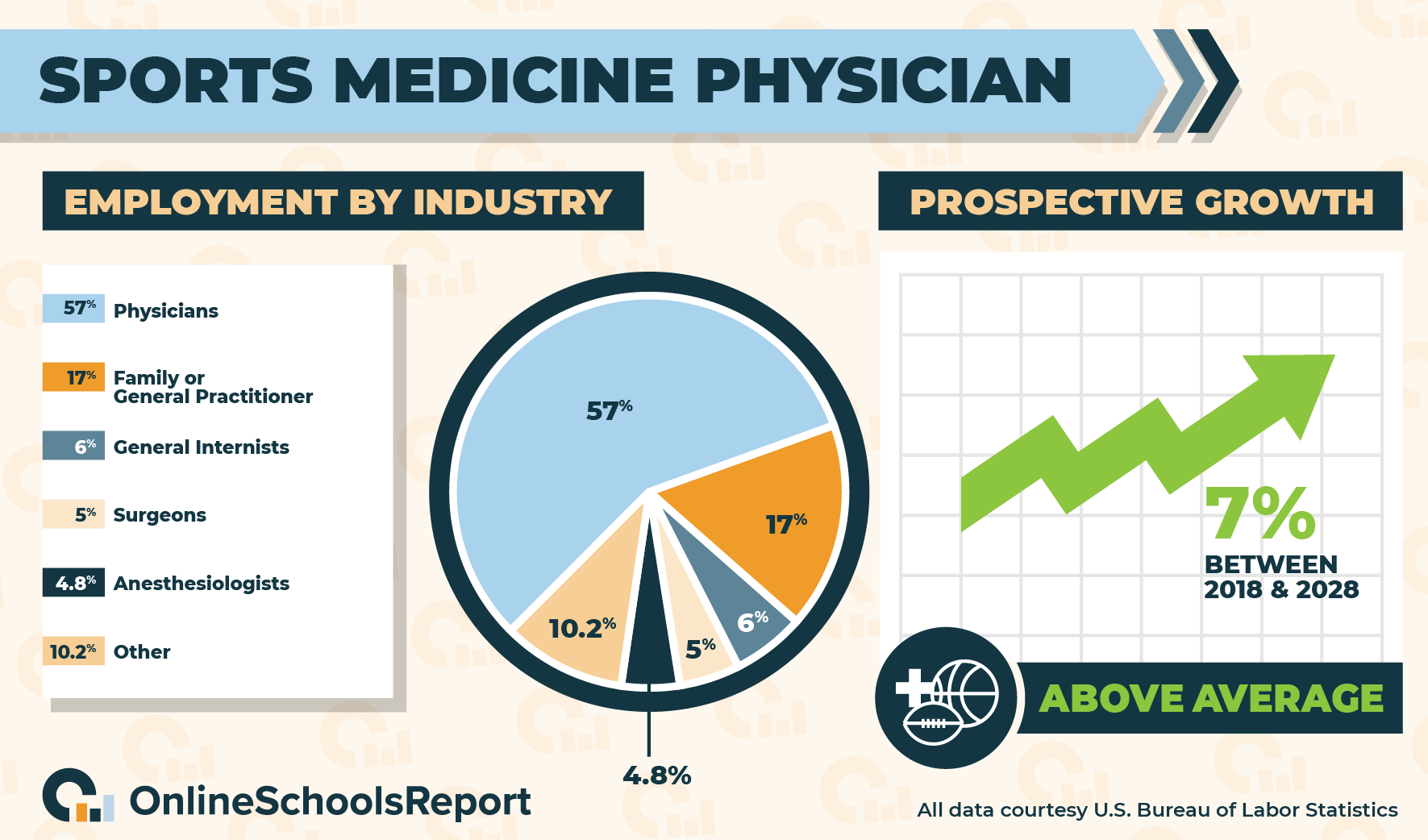
Though specific data on physicians specializing in sports medicine is unavailable, data from the BLS related to physicians and surgeons in general says that roughly 57% find work as physicians, while roughly 17% work for a family or general practitioner.
Following that, about 6% work as general internists, 5% work as surgeons specifically, and about 4.8% work anesthesiologists. States with high levels of employment for physicians and surgeons in general include New York and California.
Professional organizations in the field of sports medicine include the American College of Sports Medicine, and the American Medical Athletic Association, among many others.
To get the full picture of the job outlook for physicians specializing in sports medicine specifically, consider that every professional or college-level sports team employs one, and sports medicine specialty clinics are increasingly common across the U.S.
Athletic Trainers

Athletic trainers are the non-medical counterpart to sports medicine physicians and physical therapists. While athletic trainers can’t carry a severely injured athlete through every rehabilitative step, they are perhaps the most prepared professionals to immediately diagnose and treat injuries.
They are the first responders for injured players for sports teams at the elementary, secondary,, high school, university, and professional levels. Athletic trainers are the people on the field assessing injuries and helping injured players walk off the field.
They also bandage and tape athletes who have been given medical clearance by certified medical professionals. In other words, athletic trainers are to physical therapists what EMTs are to doctors in the ICU.
Often, athletic trainers also work on an administrative level in sports teams and school settings, and they may also help with creating budget, craft and implement policies, and plan other aspects of an athletic program.
A bachelor’s degree must first be completed to work as an athletic trainer, most commonly in sports medicine, where students learn anatomy, biology, nutrition, and physiology.
Although a bachelor’s degree is all that’s required to work as an athletic trainer, a master’s degree from a school approved by the Commission on Accreditation of Athletic Training Education will boost income potential and job opportunities. Many states require the credential Athletic Trainer Certified, or ATC, granted by the Board of Certification (BOC).
Athletic trainers earn an average of $48,440 per year, according to the Bureau of Labor Statistics. There are just over 32,000 athletic trainers in the U.S., according the BLS, and that number is expected to grow at a rate of 16%, which is much faster that average.
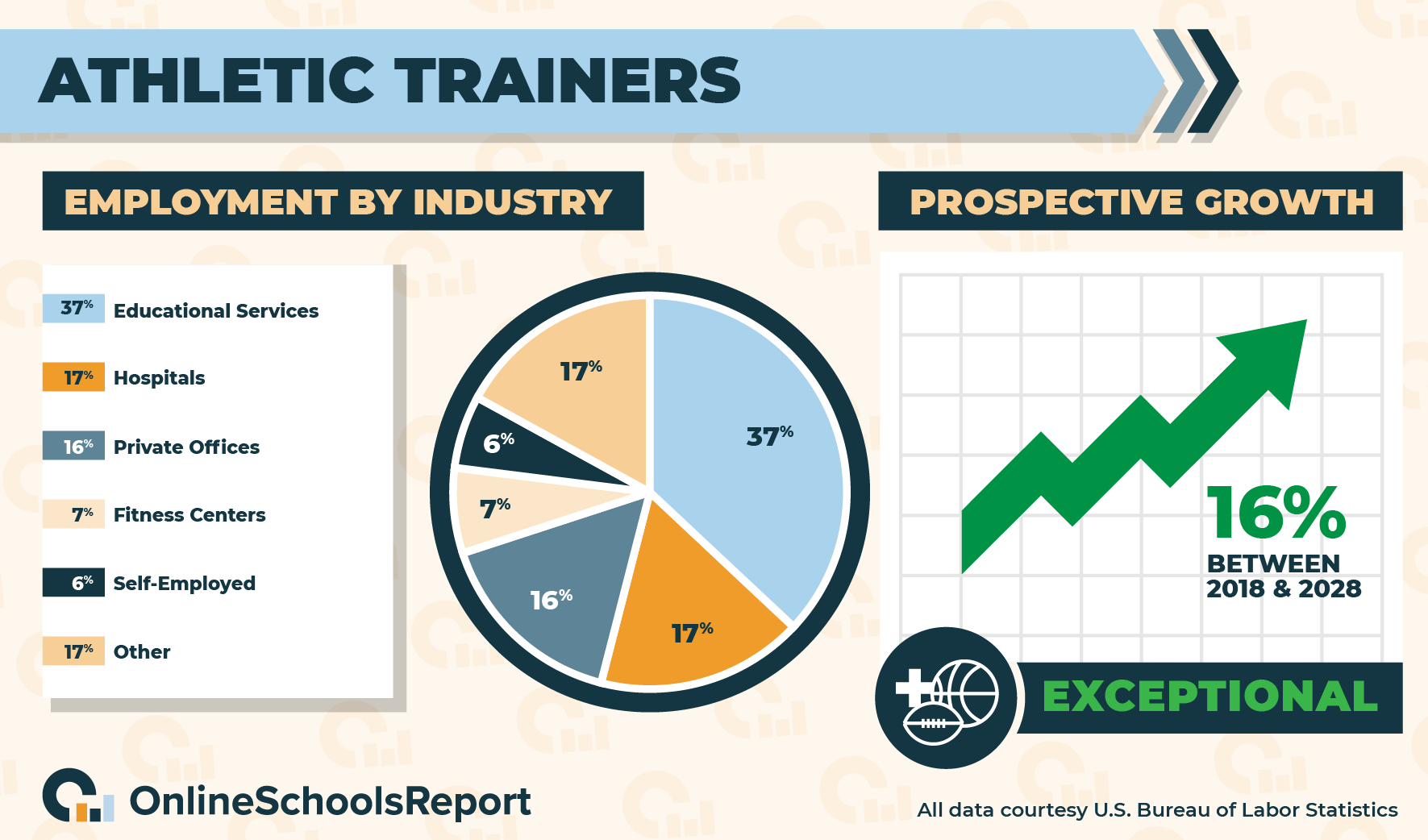
The BLS also reports that 37% work in educational services, 17% work in hospitals, 16% work out of private offices, 7% work in fitness centers, and 6% of athletic trainers are self-employed workers. States with high levels of employment in this profession include Texas and Pennsylvania.
With a few exceptions, every state requires athletic trainers to obtain a license, which is granted after passing an exam designed by the Board of Certification for the Athletic Trainer. Athletic trainers must occasionally take continuing education courses through that same board of certification.
Physical Therapist

Among all the different kinds of doctors in the field of sports medicine, physical therapists possess the broadest field of knowledge and training. They work as diagnosticians, rehabilitators, and guides, providing effective treatment plans for a broad range of sports-related injuries.
When an injured athlete comes to see a physical therapist, the process of rehabilitation begins by diagnosing the issue. A physical therapist will begin by analyzing a patient’s medical history, which will inform them of the proper course of recovery.
A bachelor’s degree in a subject like sports medicine is required to become a physical therapist. Graduate programs in physical therapy do accept students with bachelor’s degrees in subjects besides sports medicine, so long as certain courses like anatomy, physiology, biology, and chemistry are completed. Other prerequisites may be required.
After graduation, prospective students must enroll in a Doctor of Physical Therapy program. Usually lasting three years, these programs combine traditional classes with clinical experience. Some students enroll instead in a combined seven-year bachelor’s and Doctor of Physical Therapy program, providing a fast-track to completion.
It’s important to note that all physical therapy programs must be accredited by the Commission on Accreditation in Physical Therapy Education. Otherwise, you may not be able to gain a license in many states.
After graduating, aspiring physical therapists then must enroll in a clinical residency program. Lasting for one year, these programs provide details of the profession that cannot be found in a classroom setting.
According to the Bureau of Labor Statistics, as of 2019, physical therapists earn an average of $89,440 per year. There were 247,700 physical therapists in 2018, and the Bureau of Labor Statistics estimates this number will grow by an astounding 22% by the year 2028, roughly three-times faster than other professions.
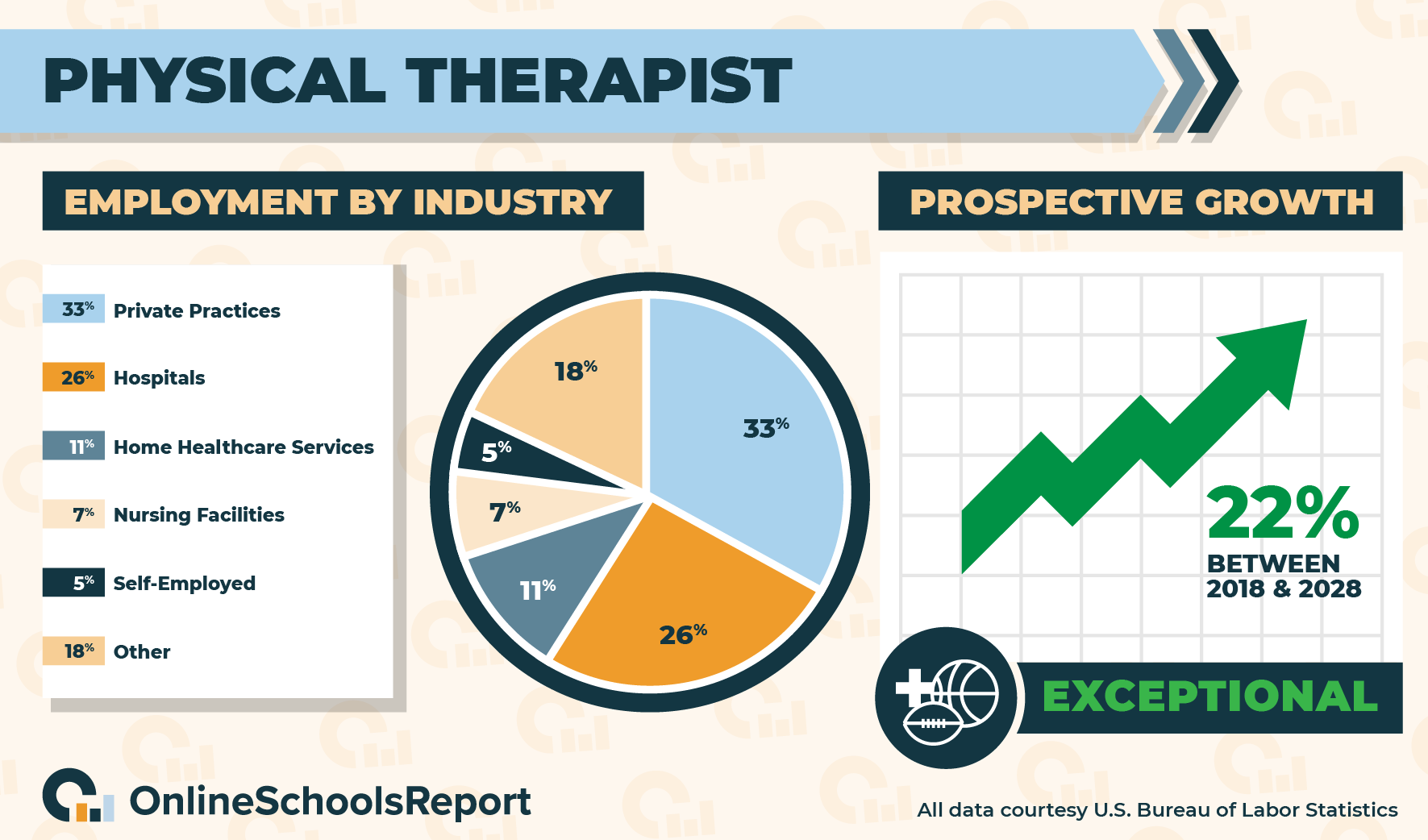
Also citing BLS data, 33% of physical therapists work in private practices, 26% work in hospitals, 11% work in home healthcare services, 7% work in nursing facilities, and 5% are self-employed. States with high levels of employment for physical therapists include California and New York.
Finally, physical therapists must obtain licensure. To do this, they must pass the National Physical Therapy Examination, which is administered by the Federation of State Boards of Physical Therapy. Depending on the state you wish to practice in, you may need to complete additional training and exams, like criminal background checks and law exams.
Dietitian and Nutritionist

Registered Dietitians (sometimes also called Registered Dietitian Nutritionists) are the first and last stop for all things food, playing a crucial role in the training and day-to-day regimens of athletes, children, the hospitalized, and the elderly. If you’re deficient in protein, for example, they may recommend healthy protein-heavy foods like fish, chicken, eggs, and plant-based proteins. If you lack iron, they may recommend lentils, beans, spinach, and apples.
Whatever your lifestyle is and wherever your body needs to go to reach optimal shape, nutritional professionals are the most trusted advisers to get you there. Many dietitians work one-on-one with clients in a private setting.
Other Registered Dietitians (RDs) deliver speeches to schools, work in a group-based environment for a sports team or in a nursing home. Others work behind-the-scenes, crafting educational materials for schools and hospitals.
There are three essential types of nutritionist professionals. Clinical dietitians and nutritionists provide medical nutrition advice in hospitals, care facilities, and private practices. Secondly, community nutritionists work with governmental and non-governmental organizations and clinics. And finally, management dieticians work in the food industry, in schools, prisons, and other places that feed dozens or hundreds of people.
The path to becoming a Registered Dietitian is far shorter than that of traditional doctors. A bachelor’s degree in a relevant field is required, like dietetics or nutrition. Degrees in sports medicine, public health, and public health nutrition may also be acceptable, so long as the program is accredited by the Accreditation Council for Education in Nutrition and Dietetics (ACEND). International Dietitian Education Programs also qualify.
Upon graduation, the next step to become a registered dietician is to complete an ACEND-accredited, supervised dietetic internship program. Candidates must then sit for the national registered dietician exam administered by the Commission on Dietetic Registration (CDR). After passing the exam, the candidate has earned their registered dietician credential.
Graduate degrees aren’t required to become a professional nutritionist or registered dietician, but many do complete advanced degrees to prove credibility, obtain administrative jobs, and simply become better educated about their chosen profession. Some complete a graduate degree in a subject like sports medicine before seeking their RD credential from ACEND.
On average, dietitians earn $61,270 per year, citing data from the Bureau of Labor Statistics. There are just under 71,000 positions in the U.S. This number is expected to grow at a rate of 11% in the decade spanning 2018–2028, which is nearly twice as fast as other professions.
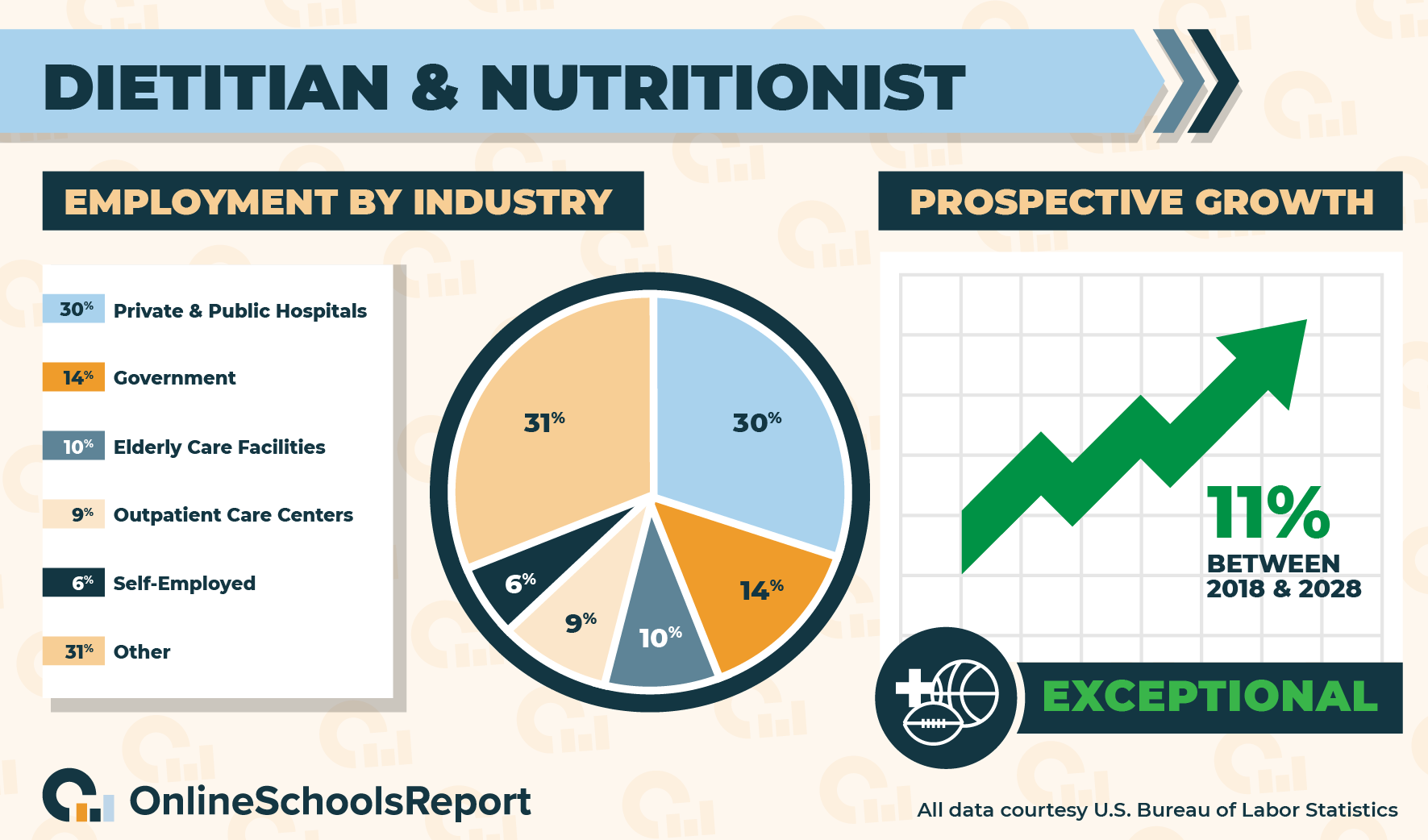
Also according to the BLS, 30% of nutritionists and dieticians work in private and public hospitals, 14% work in government, 10% work in elderly care facilities, 9% work in outpatient care centers, and 6% are self-employed. States with high levels of employment for dieticians and nutritionists include California and Texas.
Exercise Physiologist

Working with individual patients, groups, and governmental agencies, exercise physiologists design fitness programs to increase cardiovascular health and flexibility. They also may rehabilitate injured athletes, perform fitness and stress tests, and measure blood pressure, among other important health metrics.
In addition to working with injured athletes, exercise physiologists also work with the elderly, such as leading a water-based exercise program for senior citizens. A bachelor’s degree in a subject like sports medicine is required to become an exercise physiologist. Physiology, kinesiology, or exercise science are other good options.
There is no formal on-the-job training, such as an internship or residency, required in this profession, though this may vary from one employer to the next.
Though few employers require advanced degrees as a condition of employment, many exercise physiologists complete a master’s degree in sports medicine or a related field. These degrees qualify a graduate to work in an administrative role, with marginally increased pay.
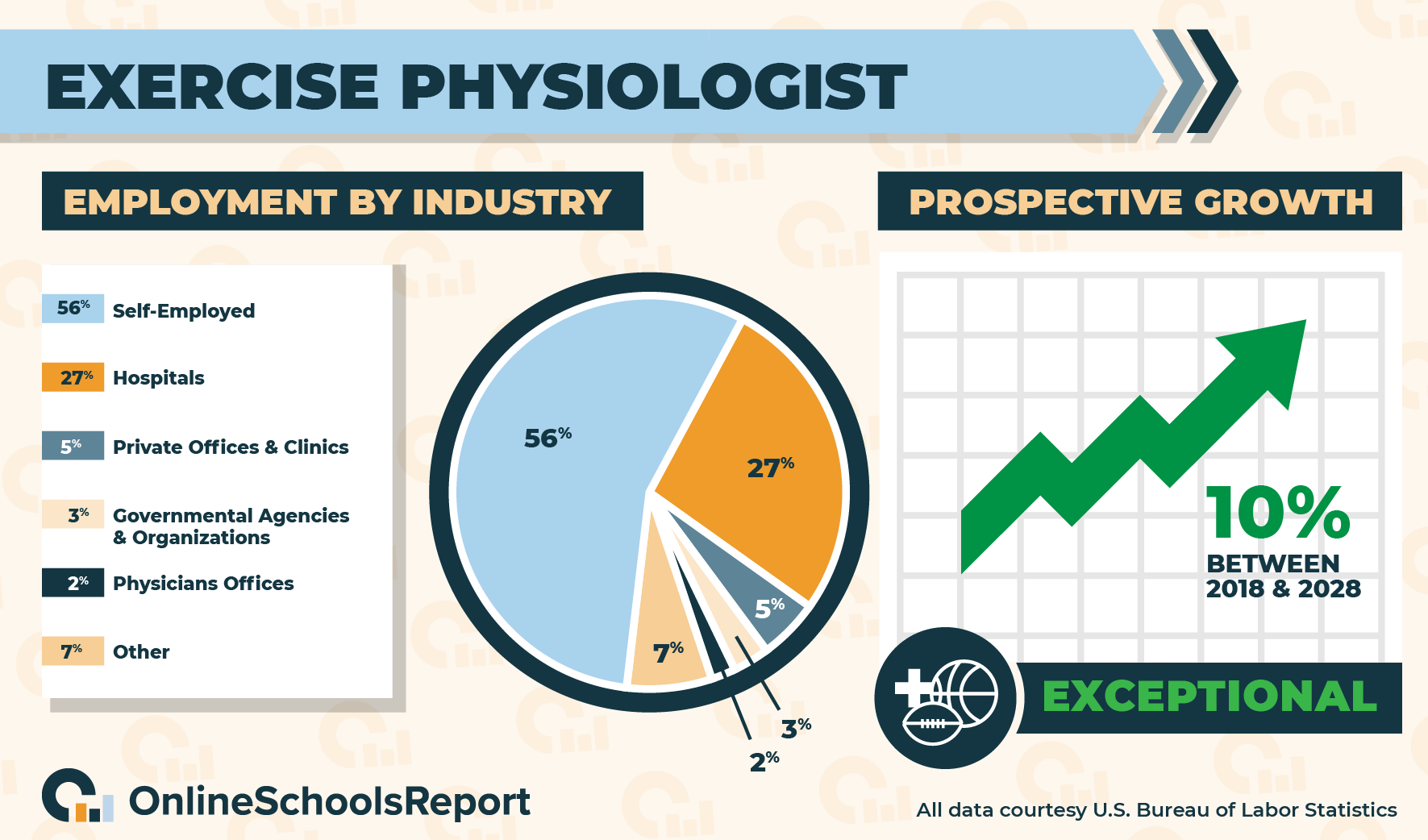
What’s important to note is that both undergraduate and graduate degrees must be accredited by the Commission on Accreditation of Allied Health Education Programs.
As of 2019, median pay for an exercise physiologist was $49,170 per year, with just about 16,000 jobs available in the U.S, according to the Bureau of Labor Statistics. Job opportunities in exercise physiology are expected to grow at a rate of 10% in the decade spanning 2018–2028, which is above average for many other professions.
At 56%, the overwhelming majority of exercise physiologists are self-employed. That’s while 27% work in hospitals, 5% work out of private offices and clinics, 3% work within governmental agencies and organizations, and 2% work in the offices of physicians. States with high levels of employment in this profession include Michigan and California.
In most states, licenses aren’t required to practice exercise physiology, though this is quickly changing in some areas of the country. CPR certification and Basic Life Support certification may be required by some employers.
Sports Medicine Degrees
There are any number of great careers waiting for you after completion of your degree in sports medicine. From associate’s degrees to doctorate’s degrees, an education in sports medicine opens up a world of possibilities. Choose your path from any one of the great degree options, outlined below.
Associate’s Degree in Sports Medicine

Although a bachelor’s degree is required by most employers as a condition for hiring, an associate’s degree in sports medicine is a great starting place for those interested in becoming an athletic trainer, or any number of great careers made possible by a degree in this area of study.
Furthermore, associate’s degrees are a great way to affordably complete the first two years of a degree more affordably than might otherwise be possible at a college or university, either in-person or online.
Subjects taught in these programs will have the vocational, hands-on emphasis common to associate’s degree programs, and credits are most-often transferable to a four-year program upon completion.
Those who pursue an associate’s degree in sports medicine at a community college, junior college, vocational or trade school, or an online program will most likely study topics like human anatomy and physiology, health and wellness, sports psychology, sports nutrition, and strength training and conditioning. Training in proper CPR and first aid procedures may also be included.
A high school diploma or equivalent is required for admittance to an associate’s degree program in sports’s medicine, as well as the completion of certain prerequisites in high school with at least a C-average, such as math, chemistry, and communications. Minimum program requirements vary between programs.
Most often 60 credits are required to complete an associate’s degree in sports medicine, or about 20 college courses. This takes most students about two years of classwork. Although many go on to complete their bachelor’s degree in sports medicine, associate’s degrees do qualify a graduate to work in entry-level positions at a gym, or as a physical therapy attendant or personal trainer.
Bachelor’s Degree in Sports Medicine

Whether transferring credits from an associate’s degree program, or whether this is the first step in an educational career, a four-year bachelor’s of science degree, or BS, is most often the minimum educational requirement to seek certification as an athletic trainer, or to become a registered dietician or professional nutritionist.
It also satisfies many requirements to apply for medical school in order to become a sports medicine physician or surgeon. A bachelor’s degree program in sports medicine will blend classwork and field work, with possible areas of emphasis ranging from sports medicine to kinesiology, physical therapy, and physical education.
Common coursework in a four-year program can include principles of medicine in the context of sports, as well as anatomy and physiology, biomechanics, exercise physiology, therapeutic modalities, injury evaluation, and injury rehabilitation.
A bachelor’s degree is the minimum educational requirement for many employers in sports medicine, or to go on to seek additional certification. Coursework will move from the vocational, hands-on approach of an associate’s degree program to a more theoretical approach to the subject matter.
In addition to general education, graduates will also receive a broad foundation in technical skills related to the treatment of sports injuries, as well as behavioral science and health. 120 credits, or 40 college courses, is required to complete most bachelor’s degree programs. This takes many students about four years.
A high school diploma or equivalent, with a GPA of at least 2.0 is required for admittance to most bachelor’s degree programs, though this can vary. An associate’s degree with a GPA of at least 2.0 may also satisfy these requirements.
Many schools also require applicants to submit their ACT or SAT scores, letters of recommendation, or a personal statement of intent.
A bachelor’s degree also qualifies a graduate to go on to a master’s or doctorate’s degree program in sports medicine, broadening employment opportunities and increasing income potential.
Master’s Degree in Sports Medicine

After completion of a BS degree in sports medicine, many students move on to pursue a master’s degree, or MS, in sports medicine at a college, university, or online institution.
Master’s degree programs complete the shift from the practical to the theoretical, and will further set a job candidate apart from other applicants. Master’s degrees, however, are rarely required to seek certification as an athletic trainer, for example. They are a great path toward medical school, as well.
Subjects taught in a sports medicine master’s program include science, biology, anatomy, and physiology. Master’s degree programs also allow for further areas of emphasis, such as nutrition or kinesiology.
A terminal thesis is also a condition for graduation from many master’s degree programs, requiring fresh insight and deep research in the subject chosen.
A bachelor’s degree is the minimum educational requirement to apply to a master’s degree program. Candidates may also need to submit their GMAT or GRE test scores as well.
Online programs are a good option for non-traditional or returning students, and many are designed to work around the schedule of working professionals, returning to school for continuing education or to increase job opportunities.
To complete a master’s degree most often takes about between 36 and 54 semester credits, or 60 to 90 quarter-credits. That’s about 12 to 18 college courses. Completion of a master’s degree program in sports medicine qualifies a graduate for certification in personal training, exercise physiology, or nutrition.
A master’s degree also qualifies many candidates to teach sports medicine in the level of college or university, or to find work in administration or other high-level managerial positions in the field of sports medicine, athletics, or fitness.
Doctorate’s Degree in Sports Medicine

Want to scale the summit of sports medicine knowledge and expertise? Then you should consider studying at the doctoral level. While PhDs in fields related to sports medicine are available (such as a PhD in Kinesiology or in Exercise and Sports Science), these are not the hands-on degrees that most sports medicine practitioners are interested in. If you want to work directly with athletes needing expert attention, then you should become either a Doctor of Athletic Training (DAT), or a Doctor of Physical Therapy (DPT)(sometimes called a Doctor of Physiotherapy). A handful of great DAT programs, the most obvious terminal degree in the sports medicine field, are offered completely online.
Although a bachelor’s or master’s degree in athletic training from a program accredited by the Commission on Accreditation of Athletic Training Education (CAATE) is technically all that’s required to work as an athletic trainer, a Doctor of Athletic Training will help separate an applicant from the competition.
The path to becoming a registered physical therapist, or RPT, as one common example, requires the completion of a bachelor’s degree, as well as the completion of a Doctor of Physical Therapy program accredited by the Commission on Accreditation in Physical Therapy Education (CAPTE). These programs typically last three years. Following that, a candidate must complete licensing requirements, which vary widely by state.
Though optional, many candidates then complete a clinical residency program, typically lasting one year, before obtaining certification from the American Board of Physical Therapy Specialties. This means they have completed at least 2,000 hours of clinical work, or an APTA-accredited residency program, before passing an exam. This is also optional.
Another fascinating degree offered at the doctoral level in a subject related to sport medicine is a PhD in Kinesiology. These degrees qualify graduates to study and research injury treatment and prevention, and the management and rehabilitation of sports-related injuries. Many graduates go on to work in research and teaching at the college or university level in subjects related to physical therapy and athletic training,
Further specialization is possible in areas related to kinesiology, such as biomedical engineering, exercise physiology and nursing in the context of sports and athletics. Other common coursework in many sports medicine-related programs can include biomechanics, statistics, and public health.





